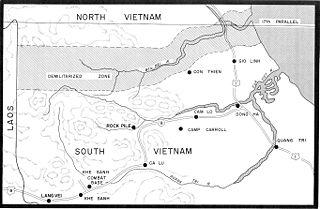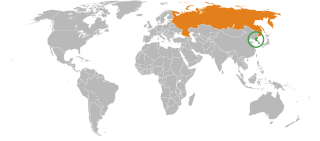The diplomatic history of the United States oscillated among three positions: isolation from diplomatic entanglements of other nations ; alliances with European and other military partners; and unilateralism, or operating on its own sovereign policy decisions. The US always was large in terms of area, but its population was small, only 4 million in 1790. Population growth was rapid, reaching 7.2 million in 1810, 32 million in 1860, 76 million in 1900, 132 million in 1940, and 316 million in 2013. Economic growth in terms of overall GDP was even faster. However, the nation's military strength was quite limited in peacetime before 1940.

A demilitarized zone is an area in which treaties or agreements between states, military powers or contending groups forbid military installations, activities, or personnel. A DZ often lies along an established frontier or boundary between two or more military powers or alliances. A DZ may sometimes form a de facto international border, such as the Korean Demilitarized Zone. Other examples of demilitarized zones are a 14 km (8.7 mi) wide area between Iraq and Kuwait; Antarctica ; and outer space.

Brinkmanship or brinksmanship is the practice of trying to achieve an advantageous outcome by pushing dangerous events to the brink of active conflict. The maneuver of pushing a situation with the opponent to the brink succeeds by forcing the opponent to back down and make concessions rather than risk engaging in a conflict that would no longer be beneficial to either side. That might be achieved through diplomatic maneuvers, by creating the impression that one is willing to use extreme methods rather than concede. The tactic occurs in international politics, foreign policy, labor relations, contemporary military strategy, terrorism, and high-stakes litigation.
Bilateralism is the conduct of political, economic, or cultural relations between two sovereign states. It is in contrast to unilateralism or multilateralism, which is activity by a single state or jointly by multiple states, respectively. When states recognize one another as sovereign states and agree to diplomatic relations, they create a bilateral relationship. States with bilateral ties will exchange diplomatic agents such as ambassadors to facilitate dialogues and cooperations.

The First Taiwan Strait Crisis was a brief armed conflict between the People's Republic of China (PRC) and the Republic of China (ROC) focused on several ROC-held islands a few miles from the Chinese mainland in the Taiwan Strait.

The Australia, New Zealand, United States Security Treaty is a 1951 collective security agreement initially formed between Australia, New Zealand, and the United States. It requires the parties to maintain their "capacity to resist armed attack", consult with each other on security matters in the Pacific and declares that an armed attack on any of the parties "would be dangerous to [each signatories] peace and safety" and that each signatory "would act to meet the common danger in accordance with its constitutional processes". It also provides for a council of the signatories foreign ministers, in which the implementation of the treaty can be discussed.

Diplomatic relations between South Korea and the United States commenced in 1949. The United States helped establish the modern state of South Korea, officially the Republic of Korea, and fought on its UN-sponsored side in the Korean War (1950–1953). During the subsequent decades, South Korea experienced tremendous economic, political and military growth.
The San Francisco System is a network of alliances pursued by the United States in the Asia-Pacific region, after the end of World War II – the United States as a "hub", and Japan, South Korea, Taiwan, the Philippines, Thailand, Australia, and New Zealand as "spokes". The system is made of bilateral political-military and economic commitments between the United States and its Asia-Pacific allies. This system stands in contrast to a multilateral alliance, such as NATO.

Pactomania is a term originally created to describe the period between 1945 and 1955, during which the United States concluded or ratified a significant amount of alliances, treaties, and pacts. The word "Pactomania" was first used in a The New York Times article in 1955.

The Mutual Defense Treaty between the United States and the Republic of China, was a defense pact signed between the United States and the Republic of China (Taiwan) effective from 1955 to 1980. It was intended to defend the island of Taiwan from invasion by the People's Republic of China. Some of its content was carried over to the Taiwan Relations Act of 1979 after the failure of the Goldwater v. Carter lawsuit.

The Soviet Union was the first to recognize North Korea on October 12, 1948, shortly after the proclamation, as the sole legitimate authority in all of Korea. The Soviet Union supported North Korea during the Korean War. North Korea was founded as part of the Communist bloc, and received major Soviet military and political support. The comprehensive personality cult around North Korea's ruling family was heavily influenced by Stalinism. China and the Soviet Union competed for influence in North Korea during the Sino-Soviet split in the 1960s, as North Korea tried to maintain good relations with both countries.

The Mutual Defense Treaty Between the United States and the Republic of the Philippines is an agreement between the two nations recognizing that an attack in the Pacific on either would endanger the peace of both and agreeing to act in concert to meet the common danger. It signed on August 30, 1951 by their representatives in Washington, D.C. and has eight articles.
The aftermath of the Korean War set the tone for Cold War tension between superpowers. The Korean War was important in the development of the Cold War, as it showed that the two superpowers, United States and Soviet Union, could fight a "limited war" in a third country. The "limited war" or "proxy war" strategy was a feature of conflicts such as the Vietnam War and the Soviet War in Afghanistan, as well as wars in Angola, Greece, and the Middle East.

The "nuclear umbrella" is a guarantee by a nuclear weapons state to defend a non-nuclear allied state. The context is usually the security alliances of the United States with Australia, Japan, South Korea, the North Atlantic Treaty Organization and the Compact of Free Association. Those alliances were formed because of the Cold War and the Soviet Union. For some countries, it was an alternative to acquiring nuclear weapons themselves; other alternatives include regional nuclear-weapon-free zones or nuclear sharing.
This timeline of nuclear weapons development is a chronological catalog of the evolution of nuclear weapons rooting from the development of the science surrounding nuclear fission and nuclear fusion. In addition to the scientific advancements, this timeline also includes several political events relating to the development of nuclear weapons. The availability of intelligence on recent advancements in nuclear weapons of several major countries is limited because of the classification of technical knowledge of nuclear weapons development.

The Korean Armistice Agreement is an armistice that brought about a cessation of hostilities of the Korean War. It was signed by United States Army Lieutenant General William Harrison Jr. and General Mark W. Clark representing the United Nations Command (UNC), North Korea leader Kim Il Sung and General Nam Il representing the Korean People's Army (KPA), and Peng Dehuai representing the Chinese People's Volunteer Army (PVA). The armistice was signed on 27 July 1953, and was designed to "ensure a complete cessation of hostilities and of all acts of armed force in Korea until a final peaceful settlement is achieved."
The Enhanced Defense Cooperation Agreement (EDCA) is an agreement between the United States and the Philippines intended to bolster the American–Philippine alliance. The agreement allows the United States to rotate troops into the Philippines for extended stays and allows the United States to build and operate facilities on Philippine bases for both American and Philippine forces. The U.S. is not allowed to establish any permanent military bases. The Philippines have personnel access to American ships and planes. This agreement has been the subject of criticism by some leftist groups in the Philippines.

The Peace Treaty on Korean Peninsula is a proposed settlement to formally end military hostilities on the Korean Peninsula as a follow-up to the 1953 Korean Armistice Agreement implemented by the United Nations after the Korean War. During the inter-Korean summit on April 27, 2018, Kim Jong-un and Moon Jae-in signed the Panmunjom Declaration; the declaration involved an agreement about mutual efforts and action items for transforming the armistice agreement into a peace treaty with the cooperation of the United States and China. During the 2018 Trump–Kim summit, US president Donald Trump and Kim signed a Joint Statement which reaffirmed the Panmunjom Declaration. On November 23, 2023, North Korea terminated its 2018 agreement with South Korea.

The U.S.-Japan Alliance is a military alliance between Japan and the United States of America, as codified in the Treaty of Mutual Cooperation and Security between the United States and Japan, which was first signed in 1951, took effect in 1952, and was amended in 1960. The alliance has further been codified in a series of "administrative" agreements, "status of forces" agreements, and secret pacts that have not been subject to legislative review in either country.















